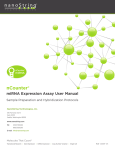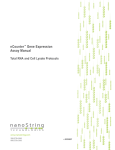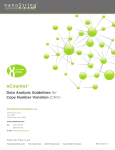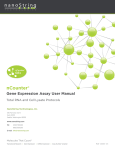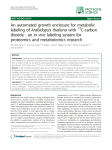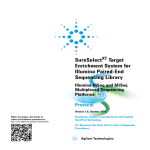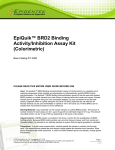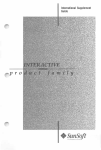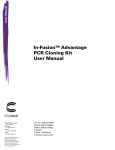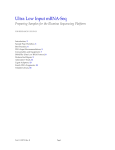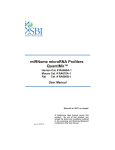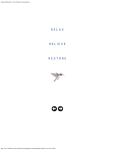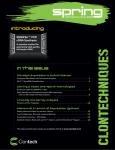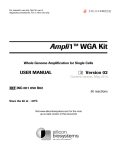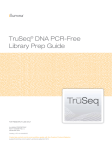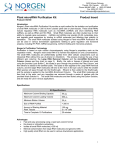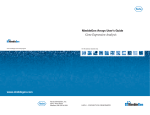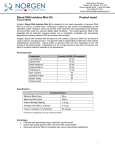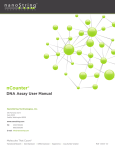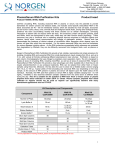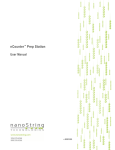Download miRNA Expression Assay Manual
Transcript
nCounter® miRNA Expression Assay Manual Sample Preparation and Hybridization Protocols MAN-C0009-03 For research use only. Not for use in diagnostic procedures. Limited License Subject to the terms and conditions of the nCounter® Analysis System contained in the product quotation, NanoString grants you a limited, non-exclusive, non-transferable, non-sublicensable, research use only license to use the proprietary nCounter Analysis System only in accordance with the manual and other written instructions provided by NanoString. Except as expressly set forth in the terms and conditions, no right or license, whether express, implied or statutory, is granted by NanoString under any intellectual property right owned by, or licensed to, NanoString by virtue of the supply of the proprietary nCounter Analysis System. Without limiting the foregoing, no right or license, whether express, implied or statutory, is granted by NanoString, to use the nCounter Analysis System with any third party product not supplied or licensed to you by NanoString, or recommended for use by NanoString in a manual or other written instruction provided by NanoString. Trademarks NanoString Technologies, NanoString, nCounter and Molecules That Count are registered trademarks or trademarks of NanoString Technologies, Inc., in the United States and/or other countries. All other trademarks and/or service marks not owned by NanoString that appear in this manual are the property of their respective owners. Copyright © 2010 NanoString Technologies, Inc. All rights reserved. Contents Chapter 1: Introduction 1 The nCounter miRNA Expression Assay . . . . . . . . . . . . . . . . . . . . . . . . . 1 Overview of miRNA Sample Preparation . . . . . . . . . . . . . . . . . . . . . . . . . . . . 1 Overview of CodeSet Hybridization and Downstream Processing . . . . . . . . . . . . . . . 2 Materials Required . . . . . . . . . . . . . . . . . . . . . . . Sample Guidelines/Recommendations . . . . . . . . . . . . . Understanding and Troubleshooting RNA Sample Contamination Thermocycler Requirement . . . . . . . . . . . . . . . . . . . Thermocycler Protocols . . . . . . . . . . . . . . . . . . . . . . . . . . . . . . . . . . . . . . . . . . . . . . . . . . . . . . . . . . . . . . . . . . . . . . . . . . . . . . . . . .3 .4 .4 .5 .5 Chapter 2: miRNA Sample Preparation Protocol 7 Chapter 3: miRNA Hybridization Protocol 9 Setting Up nCounter ® Hybridization Assays . . . . . . . . . . . . . . . . . . . . . . . . 9 ii nCounter® miRNA Expression Assay Manual 1 Introduction The nCounter miRNA Expression Assay is designed to provide an ultra-sensitive, reproducible and highly multiplexed method for detecting miRNAs in total RNA across all biological levels of expression. The assay provides a method for detecting miRNAs without the use of reverse transcription or amplification using molecular barcodes called nCounter Reporter Probes. The assay can be run on total RNA isolated from any source, including formalin-fixed paraffin embedded (FFPE) samples. This manual describes in detail the methods for both the miRNA Sample Preparation and the miRNA CodeSet Hybridization. For instructions on post-hybridization processing and data analysis please see the nCounter® Prep Station User Manual, nCounter® Digital Analyzer User Manual, and nCounter® Data Analysis Guidelines for miRNA. The nCounter miRNA Expression Assay Overview of miRNA Sample Preparation The nCounter® miRNA Sample Preparation Kit provides reagents for ligating unique oligonuceotide tags onto miRNAs, allowing these short RNAs to be detected with great specificity and sensitivity in the standard nCounter gene expression assay. The miRNA tag ligation reaction can be performed in a background of total RNA. Sample preparation involves a multiplexed annealing of the specific tags to their target miRNA, a ligation reaction, and an enzymatic purification to remove the unligated tags. Sequence specificity between each miRNA and its appropriate tag is ensured by careful, stepwise control of annealing and ligation temperatures. Control RNA included in the nCounter miRNA Sample Preparation Kit allows the user to monitor the ligation efficiency and specificity through each step of the reaction. Bridge Mature miRNA Ligation Site miRtag Sequence Figure 1.1 miRNAs are specifically ligated to unique tags for downstream detection The total hands-on time for the sample preparation reaction is approximately 30 minutes, with an elapsed time of approximately 3 hours. 2 nCounter® miRNA Expression Assay Manual Overview of CodeSet Hybridization and Downstream Processing NanoString technology is based on the direct molecular barcoding and digital detection of target molecules through the use of a color-coded probe pair. The probe pair consists of a Reporter Probe, which carries the signal on its 5' end, and a Capture Probe which carries a biotin on its 3' end. The complexity of the color codes, comprised of four colors in six positions, allows a large diversity of targets present in the same sample to be individually resolved and identified during data collection. During the overnight hybridization reaction, probe pairs are present in large excess to target RNAs to ensure that each target finds a probe pair. Figure 1.2 Capture and Reporter Probes (left) and, Probe pair bound to an RNA target (right) The nCounter miRNA expression assay is run on the nCounter Analysis system. The system is comprised of two instruments, the Prep Station used for post-hybridization processing, and the Digital Analyzer used for data collection. After hybridization, excess probes are washed away using a two step magnetic beadbased purification on the nCounter Prep Station. Magnetic beads derivatized with short nucleic acid sequences that are complementary to the Capture Probe and the Reporter Probes are used sequentially. First, the hybridization mixture containing target/probe complexes is allowed to bind to magnetic beads complementary to sequences on the Capture Probe. Wash steps are performed to remove excess Reporter Probes and non-target cellular transcripts. After washing, the Capture Probes and target/probe complexes are eluted off the beads and are hybridized to magnetic beads complementary to sequences on the Reporter Probe. An additional wash is performed to remove excess Capture Probes. Finally, the purified target/probe complexes are eluted off the beads and immobilized on the cartridge for data collection. Data Collection is carried out in the nCounter Digital Analyzer. Digital images are processed and the barcode counts are tabulated in a comma separated value (CSV) format. The nCounter miRNA Expression Assay Introduction 3 Figure 1.3 Suggested workflow for the nCounter miRNA Expression Assay Materials Required Table 1.1 Materials and Reagents Required for miRNA Sample Preparation and miRNA Expression Assay Material nCounter® Manufacturer miRNA Expression Assay Kit NanoString Technologies Total RNA Extraction Kit QIAGEN (or equivalent total RNA purification kit) Disposable gloves Various DEPC-treated (or RNAse-free) water 100ng total RNA per sample normalized to 33ng/µL Table 1.2 Instruments Required for miRNA Sample Preparation and miRNA Gene Expression Assay Material Manufacturer Spectrophotometer NanoDrop Technologies (or equivalent) Bioanalyzer 2100 Agilent Pipette for 0.5 - 10 µL Rainin (or equivalent) Pipette for 2.0 -20 µL Rainin (or equivalent) Pipette for 20 - 200 µL Rainin (or equivalent) Picofuge with strip-tube adaptor DNA Engine Thermocycler or hybridization nCounter Prep Station Stratagene (or equivalent) oven* MJ Research / BioRad (or equivalent) NanoString Technologies nCounter Digital Analyzer NanoString Technologies USB Drive NanoString Technologies * Hybridization oven can be used for the miRNA Hybridization Protocol only. A thermocycler with a heated lid is required for the miRNA Sample Preparation Protocol. Materials Required 4 nCounter® miRNA Expression Assay Manual Sample Guidelines/Recommendations The nCounter miRNA Expression Assay requires purified total RNA as input material. NanoString recommends the use of approximately 100 ng of total RNA, as this quantity of input material generates robust signal for most tissue and cell isolates. Total RNA purified from any cell or tissue type may be used in the assay, including formalin-fixed, paraffin-embedded (FFPE) material. Unpurified lysates may not be used with the nCounter miRNA Expression assay, as the denaturants in the homogenization buffer will inhibit the sample preparation reaction. The quality of the purified RNA is critically important for the nCounter miRNA assay, as residual contaminants left over from lysis and RNA extraction can impact assay performance by inhibiting the enzymatic ligation and purification steps. Typical lysis or extraction contaminants that can inhibit the assay include: • Guanidinium Isothiocyanate (lysis buffer) • Phenol (organic extraction) • Guanidinium HCl (initial wash buffer) • Ethanol (secondary wash buffer) Purified RNA quality can be evaluated via a spectrophotometer by measuring absorbance at 230 nm (A230), 260 nm (A260) and 280 nm (A280). The A260/ A280 ratio can help identify contamination with proteins, whereas the A260/A230 ratio can help identify contamination with organic compounds, such as phenol, and guanidinium salts. NanoString recommends a 260/280 ratio of 1.9 or greater and a 260/230 ratio of 1.8 or greater for optimal results. Understanding and Troubleshooting RNA Sample Contamination Significant absorbance at 280 nm can indicate contamination with protein. Such contamination may lead to an overestimation of the RNA concentration, resulting in a lower than anticipated signal in the assay. Significant absorbance at 230 nm is indicative of contamination with phenol or guanidinium; a “pure” RNA sample should have a A260/A230 ratio above 2.0. Extra washes with a secondary wash buffer or ethanol can help to minimize carry though. It is also important that residual secondary wash buffer be removed prior to elution/ resuspension. N OTE : • At very low RNA concentrations (under ~10 ng/µL), the A 260/A 230 ratio may be unreliable as an indicator of contamination, due to limited nucleic acid absorbance at 260 nm. NanoString recommends preparing samples with a concentration of > 33 ng/µL, allowing 100 ng of total RNA to be added to the sample preparation reaction in the available 3 µL volume. • Some RNA extraction protocols suggest that better yield can be achieved by re-eluting the column with the initial eluate. NanoString does not recommend this, as the extra elution can generate significant carry through of guanidinium and organic contamination. If re-elution must be performed, it should be preceded by at least 2 additional column washes with the secondary ethanol-based wash buffer (for a total of 4 secondary washes). Sample Guidelines/Recommendations Introduction 5 Ethanol is not evident spectrophotometrically, but can be eliminated by a one minute post-wash centrifugation in a clean collection tube, as is suggested in most kit protocols. Additionally, air-drying the filter for five minutes can help if ethanol contamination persists. Thermocycler Requirement The thermocycler used for the miRNA Sample Preparation Protocol must have a heated lid. For best results, NanoString recommends calibrating the thermocycler before using this assay. Thermocycler Protocols The nCounter miRNA Preparation protocol requires careful temperature control of all reaction steps. A thermocycler with a heated lid is critical for this procedure. Before beginning, program the following thermocycler protocols: Table 1.3 Annealing Protocol Temperature Time 94°C 1 min 65°C 2 min 45°C 10 min 48°C hold Total Time 13 min Table 1.4 Ligation Protocol Temperature Time 48°C 3 min 47°C 3 min 46°C 3 min 45°C 5 min 65°C 10 min 4°C hold Total Time 24 min Table 1.5 Purification Protocol Temperature Time 37°C 2 hours 70°C 10 min 4°C hold Total Time 2 hours 10 min Thermocycler Requirement 6 nCounter® miRNA Expression Assay Manual Thermocycler Protocols 2 miRNA Sample Preparation Protocol The nCounter miRNA Expression Assay requires purified total RNA as input material. NanoString recommends the use of ~100 ng total RNA, as this quantity of input material generates robust signal for most tissue/cell isolates. Purified RNA quality is also important as residual organics (phenol, etc.) can impact assay performance. NanoString recommends a minimum 280/260 ratio of 1.9 and a minimum 260/230 ratio of 1.8. All experiments should be designed in sets of twelve assays. The protocol below is for one set of 12 assays. All reagents are supplied in 12 reaction aliquots. 1. Normalize RNA samples to 33 ng/µL using DEPC (or RNAse-free) H20. 2. Prepare a 1:500 dilution of the miRNA Assay Controls. To do this, we recommend adding 499 µL DEPC H20 to 1 µL of the miRNA Assay Controls in a sterile microcetrifuge tube. Mix by vortexing and briefly spin down. Store on ice. 3. Prepare an annealing master mix by combining 13 µL of Annealing Buffer, 26 µL of nCounter miRNA Tag Reagent and 6.5 µL of the 1:500 miRNA Assay Controls dilution prepared in Step 2. Mix well by pipetting up and down. 4. Aliquot 3.5 µL of the annealing master mix into each tube of a 12 x 0.2 mL strip tube. 5. Add 3 µL (100 ng) of RNA sample to each tube. Cap tubes and flick tubes gently to mix. Spin down. 6. Place strip in thermocycler and initiate Annealing Protocol. 7. Combine 19.5 µL PEG and 13 µL Ligation Buffer to prepare a ligation master mix. N OTE : PEG is viscous and should be pipetted slowly to ensure accurate transfer of volume into the mix. Mix well by pipetting up and down. 8. Following completion of the Annealing Protocol, when the thermocycler has reached 48°C, add 2.5 µL of the ligation master mix to each tube. (Do not turn off the thermocycler; you will need the block to be at 48°C in Step 9 and Step 10). Flick tubes gently to mix and spin down. 9. Return tubes to 48°C thermocycler, close lid, and incubate at 48°C for 5 min. W ARNING: For Step 10, DO NOT REMOVE TUBES FROM THE THERMOCYCLER. Maintaining the temperature of the tubes at 48°C is critical for optimal assay performance. Tubes should never be removed from heat block during this step. 8 nCounter® miRNA Expression Assay Manual 10. Open thermocycler, carefully remove caps from tubes, leaving strip in place in the heat block, and add 1.0 µL of Ligase directly to each tube while incubating at 48°C. Check the pipette tip to make certain all of the ligase was added to the reaction. There is no need to mix. N OTE : To keep track of Ligase addition to sequential samples, it can be helpful to line up 12 tips in front of thermocycler, discarding each tip after use. 11. Immediately after addition of Ligase to the final tube, recap tubes (leaving tubes in heat block), close thermocycler, and initiate Ligation Protocol. 12. After completion of Ligation Protocol, add 1 µL Ligation Clean-Up Enzyme to each reaction. The tubes can be removed from the heat block for this step. Flick tubes gently to mix. Spin down. 13. Return tubes to thermocycler and initiate Purification Protocol. 14. After completion of Purification Protocol, add 40 µL DEPC (or RNAse-free) H2O to each sample. Mix well and spin down. (If necessary, at this stage purified sample preparation reactions may be stored at –20°C for up to several weeks.) Be sure to denature (Step 5 of Chapter 3, miRNA Hybridization Protocol) before adding prepared sample in the hybridization protocol.) 15. Proceed immediately with the miRNA CodeSet Hybridization Protocol, which is described in Chapter 3 of this manual. 3 miRNA Hybridization Protocol This chapter outlines the nCounter miRNA Hybridization Protocol and provides instructions for setting up 12 nCounter Assays. Setting Up nCounter ® Hybridization Assays G ENERAL P ROBE H ANDLING W ARNING: During the setup of your assay, do not vortex or pipet reactions vigorously to mix as it may shear the Reporter Probes. Mixing should be done by flicking or inverting the tubes. Do not spin tubes any faster than 1,000 rpm for more than 30 seconds; do not “pulse” microfuge to spin as that will cause the centrifuge to go to maximum speed and you may spin your CodeSet out of solution. The final hybridization reaction will contain the following components: 10 µL Reporter CodeSet, 10 µL hybridization buffer, a 5 µL aliquot from the miRNA Sample Preparation Protocol, and 5 µL Capture ProbeSet. The order of addition of components is important; please follow the protocol exactly. 1. Remove aliquots of both the Reporter CodeSet and Capture ProbeSet reagent from the freezer and thaw on ice. Invert several times to mix well and briefly spin down reagent at <1000 rpm (see handling considerations above). 2. Create a master mix containing 130 µL of the Reporter CodeSet and 130 µL of hybridization buffer by adding the hybridization buffer to the tube containing the Reporter CodeSet. Do not add the Capture ProbeSet to the master mix. Invert to mix and spin down master mix. 3. Label a provided 12 tube strip and cut it in half so it will fit in a picofuge. 4. Add 20 µL of master mix to each of the 12 tubes. N OTE : It is advisable to use a fresh tip for each pipetting step to pipet the correct volume. The CodeSet has components that can start to wick up into the tip and not dispense the correct amount if you use the same tip to dispense master mix into all of the hybridization tubes. 5. Denature samples from the miRNA sample prep protocol at 85°C for 5 minutes and quick-cool on ice. Add a 5 µL aliquot from the miRNA Sample Preparation Protocol to each tube. 10 nCounter® miRNA Expression Assay Manual 6. Pre-heat thermocycler to 65°C. Program the thermocycler using 30 µL volume, calculated temperature, heated lid and “forever” time setting. Do not set the thermocycler to ramp down to 4°C at the end of the run. N OTE : If a thermocycler is not available, a 65°C hybridization oven may be used. (The use of a thermocycler is recommended if possible. Due to less stringent temperature control, assay results may be more variable in a hybridization oven.) To use a hybridization oven, place a large beaker full of water in the oven to ensure a humid environment. Do not place the samples in the water beaker; evaporative loss causes the water temperature to be below the air temperature in the oven. Place the samples in a dry rack in the middle of the oven shelf, or tape the strip tubes to a rotator in the center of the oven. Make sure that the strip tubes and/or rack do not touch the sides or bottom of the oven. Failure to follow these instructions may result in uneven hybridization temperatures which can compromise the results. 7. Add 5 μL of Capture ProbeSet to each tube immediately before placing at 65°C. Cap tubes and mix the reagents by inverting the strip tubes several times and flicking with your finger to ensure complete mixing. Briefly spin down at <1000 rpm and immediately place the strip tube in the 65°C thermocycler. Minimizing the time between the addition of the Capture ProbeSet and the placement of the reaction at 65°C will increase the sensitivity of your assay. 8. Incubate hybridization assays for at least 12 hours. Hybridizations should be left at 65°C until ready for processing. Maximum hybridization time should not exceed 30 hours. 9. Once removed from the thermocycler, proceed immediately to post-hybridization processing with the nCounter Prep Station as described in the nCounter® Prep Station User Manual. Do not store hybridizations at 4°C. MAN-C0009-03 Setting Up nCounter ® Hybridization Assays














